Island Mice Project
Overview

Farallon Islands
Photo By: Megan Serr
Islands are home to an enormous variety of species. Islands contain 5% of the Earth’s landmass but contain 20% of all bird, reptile, and plant species.1 Islands have also been home to 80% of all known extinctions and 40% of all critically endangered species. As discussed in the section, Why Islands?, many conservationists often work on islands for these very reasons. Invasive species are recognized as the second leading cause of global biodiversity loss behind habitat loss.2 On islands invasive rodent species are a major concern because they are omnivorous, adaptable to multiple habitats and ecosystems, and occur on 90% of all islands.3 To protect the biodiversity of islands conservationists, including government officials, researchers, and non-governmental organizations, eradicate invasive species from islands. An eradication campaign can be a monumental effort taking years to plan and millions of dollars to enact.
What is an eradication campaign?
An eradication campaign attempts to kill every individual of an invasive species occupying an island. Given the ecology of rodents on islands this can be an extremely daunting challenge. Rodents are common pests in agricultural systems and human settlements but these pest populations are controlled at populations where agricultural losses and human health impacts are kept low.4 This is because it is much more cost effective to limit a population versus eradicating a population. Agricultural systems and human settlements are also very likely to be re-invaded by surrounding populations. But on islands the most cost effective action is to remove all the individuals at once. This is also the only way to ensure rodents do not continue harming an island’s biodiversity.
The first successful eradication of an invasive rodent occurred in New Zealand on a tiny island of just .004 sq. miles (.01 sq. km).5 Current island eradication efforts include an eradication of 386 sq. mi (1,000 sq. km) South Georgia Island in the Atlantic Ocean. A detailed summary of the growth and evolution of rodent eradications on islands can be found at History of Rodent Eradications.
Preview of ‘Current and past eradication techniques’
Our section ‘Current and Past Eradication Techniques’ reviews past eradication campaigns and their development over time. The History of Rodent Eradications summarizes the major changes and challenges that proponents of rodent eradication campaigns have withstood and continue to grapple with. The Ecology of Eradications describes the ecological principles that guide island eradication campaigns. The options chart gives more detailed accounts of the methods used to eradicate rodents as well as approaches that have been considered but not deployed. We also consider why an eradication campaign would not be pursued or would be rejected for an island on No Methods Applied.
References
- Island Conservation. (2007). Island Conservation- Why Islands. Available at <http://www.islandconservation.org/why/?id=71> Last accessed on 14 May 2014.
- Soulé, M. (1990). The Onslaught of Alien Species, and Other Challenges in the Coming Decades*. Conservation Biology, 4(3), 233–239.
- Towns, D. R., Atkinson, I. A., & Daugherty, C. H. (2006). Have the harmful effects of introduced rats on islands been exaggerated?. Biological invasions,8(4), 863-891.
- Buckle, A. P., & Smith, R. H. (1994). Rodent pests and their control. CAB international.
- Thomas, B. W., & Taylor, R. H. (1993). A history of ground-based rodent eradication techniques developed in New Zealand,1959-1993. Turning the tide: the eradication of invasive species, 301–310.
History of Rodent Eradications
How did rodents invade islands?
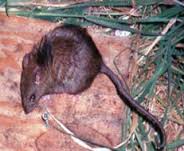
Polynesians refer to the Polynesian rat as the kiore (R. exulans.). The kiore has spiritual value to many Polynesian descendants.
Photo: Courtesy of Wikipedia
During the age of exploration, ships from Europe traversed the globe. Stowed away on these ships, brown rats (Rattus norvegicus), black rats (Rattus rattus), and house mice (Mus musculus) also reached islands across the globe. These rodents originated in central Eurasia and followed human settlement across Europe. As Europeans explored the world, these rodents followed. The rodents would walk across rope, hide within cargo, or swim to new land masses, including islands, when the ships docked to trade or gather food and supplies. The brown rat (R. norvegicus) relies on animal consumption more than the Polynesian rat, and the black rat is an exceptional climber (it is also commonly referred to as a roof rat).3 Evidence suggests these rat species have caused more extinctions and suppressed more species than Polynesian rats.2 Most invasive rodents were introduced to islands before native animal populations could be studied, so identifying the impacts caused by invasive rodents can be difficult. The invasion of Lord Howe Island in Australia provides direct evidence of the devastating effects of invasive rodents. In 1918 a ship ran aground and black rats invaded the island. Within 5 years, five forest birds became extinct.2 More information on the history of rodent associations with humans can be found at Human Mouse Relationships.
Where did rodent eradications begin?
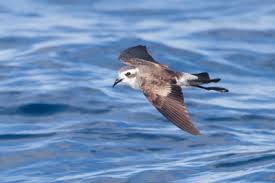
Rodenticides were distributed to eradicate mice from white-faced storm petrel colonies. Photo By: JJ Harrison.
It wasn’t until the end of the 19th century that naturalists in New Zealand and Australia began to realize the impacts of invasive species on native populations. In the 1950s and 1960s conservationists began to give more attention to invasive rodents on islands. Between 1959 and 1961, A. McDonald and members of the Royal Forest and Birds Protection Society of New Zealand, with aid from Don Merton and the New Zealand Wildlife Service, distributed rodenticide around white-faced storm petrel (Pelagodroma marina) colonies on Maria Island.4 The brown rats (R. norvegicus) on the island were known to consume the petrels, and subsequent surveys of the island revealed that this work successfully eradicated the invasive rat population. This is regarded as the first modern, deliberate eradication of an invasive rodent population on an oceanic island. Since that time rodents have been eradicated from over 280 islands around the world.5
The proliferation of rodent eradications
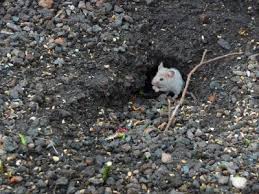
Eradications of the house mouse have been less successful than rat eradications. Photo By: Zauber.
The eradication of brown rats from Maria Island marked the beginning of the modern movement to eradicate invasive rodents from islands. Maria Island was only .004 sq. miles (.01 sq. km). The largest successful eradication to ever take place was completed in 2014 off the coast of Australia on Macquarie Island, which is 49 sq. miles (127 sq. km). Currently, an eradication effort is taking place on South Georgia in the south Atlantic. The area to be cleared on South Georgia is 386 sq. mi (1,000 sq. km) and the eradication had been split into three phases. The enormity of the islands and the isolation of independent mouse populations allows the restoration team to perform the eradication over several years. More information on the South Georgia mouse eradication can be found at this website.
The ability of eradication practitioners to target these enormous islands can be attributed to multiple advancements in the methodology of rodent eradications. Rodenticide is the most common method used, larger islands requiring the use of helicopters equipped with GPS units to drop toxicants in precise transects across islands. The section, Toxicants, further explores the use of chemicals in eradication campaigns. The sections, Mechanical Methods, Biological Controls, and Other Approaches further discuss the shortcomings of other invasive species control methods for island eradication of rodents. The Methods at-a-glance Table briefly compares these methods as well as a proposed genetically modified mouse method.
Eradication campaigns are costly endeavors, but government conservation agencies have been more willing to attempt them with the scientific evidence of biodiversity recovery following rodent eradications1 and more successful eradications on larger islands. Invasive rodent eradications have now occurred on islands all over the world. The formation of the environmental non-governmental conservation, Island Conservation, marked an important milestone in the history of island eradications. Island Conservation was formed by a small group of scientists and conservationists in 1994 when they began eradicating invasive species from islands in Mexico’s Golfo de California. Today, Island Conservation coordinates with researchers, government agencies, local communities, and other non-governmental organizations in eradication campaigns across the globe. To date, Island Conservation has eradicated 977 invasive species populations from 52 islands.6 Island Conservation has created the Database of Island Invasive Species Eradications for land managers and conservation practitioners to learn more about invasive species eradications. This database can be viewed at this website.
Island eradications of house mouse (M. musculus) have been less successful than rat eradications.7 This has largely been attributed to the smaller home range of the house mouse. A smaller home range means that there is a lower chance of a rodenticide being consumed by every mouse. While mice aren’t typically considered as threatening to biodiversity as the larger rat species mice are highly adaptive. For instance, mice eat chicks, threatening critically endangered Tristan albatross (Diomedea dabbenena) chicks on Gough Island. The first reported large scale invasive mouse eradication occurred in 1971, on Flatey Island, Iceland.8
Complicating Success
For practitioners of invasive species eradications, success is largely based on a single criterion – the eradication of the target species. The tactics used by practitioners are meant to maximize the chances of an eradication campaign’s success. But practitioners also realize that methods involving rodenticide have drawbacks, including negative impacts on non-target species. The social and ecological complexities surrounding the eradication campaigns on Anacapa Island and Rat Island in the United States help explain these complexities.
Anacapa Island is part of Channel Islands National Park and is 11 miles off the coast of Southern California. This island was infested with black rats (R. rattus) which were hammering the multiple species of insects, other invertebrates, plants, and birds including the threatened Scripps’s murrelet (Synthliboramphus scrippsi) population. Unlike islands in New Zealand, Anacapa Island contains native land-dwelling mammal populations of island deer mice (Peromyscus maniculatus spp.). Park Service employees trapped and removed the native mice to protect them from the rodenticide drop. This eradication campaign was also planned near highly populated areas of Southern California. Many people, including vocal animal rights activists, were opposed to the eradication. Opposition questioned the safety of toxicants, the vulnerability of native species to the toxicant, and whether the rats were even affecting native invertebrate, plant, and bird populations. The most cited concern was the gruesome death that follows ingestion of the proposed toxicant. A rodent that ingests these toxicants will bleed to death over the course of several days. A further discussion on the use toxicants is at the section, Toxicants.
Another rodent eradication that developed complications occurred on Rat Island, an island that is part of the Aleutian Islands in Alaska. Rat Island was officially declared free of brown rats (R. norvegicus) in 2009. The island has since been re-named, Hawadax Island. But immediately following the eradication, over three hundred dead glaucous-winged gulls (Larus glaucescens) and forty bald eagles (Haliaeetus leucocephalus) were collected from the island. Most of the birds sampled contained lethal doses of toxicants meant for the rats. An internal investigation examined the planning and execution of the eradication campaign. Although the investigation found no evidence of wrong-doing and the bird populations have not been permanently damaged, this event remains on the minds of conservation practitioners today.
Rodent eradications today
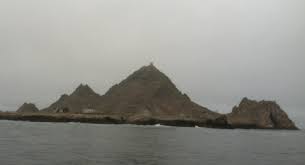
A house mouse eradication is being planned for the Farallon Islands off the coast of San Francisco. Photo By: John Godwin.
While many conservationists lament the use of toxicants for rodent eradications, an ideal alternative has not been found and opposition to eradication campaigns, largely based on the welfare of rodents, continues. Conservationists continue island eradications with a greater appreciation of the risks involved as well as a growing confidence in their ability to protect the biodiversity of the world’s islands. Australia’s Macquarie Island, a World Heritage Site, was declared rodent-free in early 2014. An integrated approach involving pesticides, traps, and hunting was employed to eradicate invasive mouse, rat, and rabbit populations. The third and final stage of the massive South Georgia eradication campaign is slated for completion in 2015. The Galapagos National Park Service and Island Conservation are engaged in a series of rat eradications from smaller islands in the Galapagos. The U.S. Fish and Wildlife Service is planning a house mouse eradication campaign for the Farallon Islands, off the coast of San Francisco. A further exploration of the proposed Farallon Island eradication campaign can be found in the section, Toxicants.
References
- Stolzenburg, W. (2011). Rat Island: Predators in Paradise and the World’s Greatest Wildlife Rescue. Bloomsbury Publishing USA.
- Towns, D. R., Atkinson, I. A., & Daugherty, C. H. (2006). Have the harmful effects of introduced rats on islands been exaggerated?. Biological invasions,8(4), 863-891.
- Buckle, A. P., & Smith, R. H. (1994). Rodent pests and their control. CAB international.
- Thomas, B. W., & Taylor, R. H. (1993). A history of ground-based rodent eradication techniques developed in New Zealand , 1959-1993. Turning the tide: the eradication of invasive species, 301–310.
- Howald, G., Donlan, C., Galván, J. P., Russell, J. C., Parkes, J., Samaniego, A., … & Tershy, B. (2007). Invasive rodent eradication on islands. Conservation Biology, 21(5), 1258-1268.
- Island Conservation. (2007). Island Conservation- Accomplishments. Available at <http://www.islandconservation.org/accomplishments/?id=3> Last accessed on 7 May 2014.
- Howald, G., Donlan, C. J., Galván, J. P., Russell, J. C., Parkes, J., Samaniego, A., … Tershy, B. (2007). Invasive rodent eradication on islands. Conservation Biology : The Journal of the Society for Conservation Biology, 21(5), 1258–68.
- Moors, P. J., Atkinson, I. A. E., & Sherley, G. H. (1992). Reducing the rat threat to island birds. Bird Conservation International, 2, 93-114.
Why is Ecology Important for Eradications?
The goal of eradication is to remove the population of a particular species. Depending on how the eradication is managed, this population reduction might fail in the end. Additionally, the eradication might affect populations of other species that are not intended to be harmed. What can be done when faced with complicated interactions between organisms? Fortunately there is already a large body of theory, known as ecology, that studies how populations of species change and interact over time. We will try to answer a few important concerns that ecology can help to answer.
What makes an eradication successful?
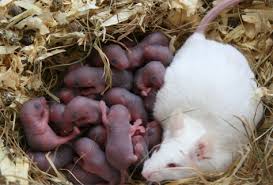
As long as a single pregnant female mouse gives birth to both male and female offspring, the mouse population size can grow again. Photo By: Seweryn Olkowicz.
In terms of eradication, there is usually a large qualitative difference between reducing the population size to zero and reducing the size to near zero. While a reduction in population size can often achieve a similar result to a complete eradication, there is always potential for a small population to rebound back to the same population levels prior to the eradication. Even a single pregnant female mouse might produce enough offspring to result in the resurgence of the population levels after a few generations. Also, if the population does not rebound, it might require constant management to keep the population size low. Therefore, the ultimate goal of any eradication strategy should usually be the complete removal of the species from the island.
When is the eradication over?
Unfortunately, even if a complete eradication does occur, there is always the potential of a recolonization event. As described above, a single pregnant female mouse can cause a population to rebound. Thus, one colonizer can effectively make the eradication efforts for naught. Because of this, there is need for strict management of what might travel in and out of the ecosystem. If there is no reliable way to regulate this, a full eradication might never be possible.
Do mouse eradications always go as intended?
While current eradication methods (mostly through toxicants) are fairly effective at eradicating rat species from islands, mouse eradications have been less successful.1 One factor to consider when eradicating mice, in particular, is that they do not have high dispersal rates and they spend a majority of their lives within a very small radius. Thus, they may not come into contact with the toxicant bait, traps, or other removal methods.2
How does eradication affect other species?
Even if someone is only interested in targeting one species for eradication, this eradication might directly or indirectly affect other species. While most current eradication strategies are developed to limit their effects on other species, it is very difficult to find a toxicant, mechanical trap, or predatory species that only target a species of interest.
All species are likely interacting with one another directly or indirectly within an ecosystem’s food web. Therefore, changing the population size of one species can at least somewhat affect the population size of other species in the ecosystem. 3, 4 There is even the possibility that an eradication of one species of rodent complicates the removal of another. For example, the eradication of a rat population might lead to an increase in the population size of a competing mouse species.2, 5
What if we just leave things the way they are?
There is always choice not to eradicate. In this case, one might expect the species to remain at its current population level. This would be less than desirable if the species is already causing a problem. However, even without direct action, the future population levels can change from what they currently are over time. It is possible for populations to decrease naturally, though it is difficult to predict when and why this happens. For a worst-case scenario, the population could also continue to expand and threaten the ecological stability of the island.
What are the limitations of ecological theory?
Ecology is inherently complex. Any particular species, or even individual organism, has the potential to create disproportionately large effects on the rest of the ecosystem. Therefore, small changes can often have large outcomes that are difficult to predict. Additionally, small random events can alter an ecosystem such that even the most well established ecological theory cannot predict the results. Thus, we must emphasize that no matter how much we elaborate on potential ecological issues that could arise from eradication (especially when considering releasing genetically modified rodents), we cannot create an exhaustive list of all possible outcomes.
How do we act with so much uncertainty?
While this should encourage more experimental research, it is difficult to experimentally study all of the indirect ecological effects of any eradication approach (this is especially important when considering the untested technique of releasing genetically modified mice). This can be somewhat remedied by using mathematical models to replicate ecological dynamics and help predict what might happen without disrupting entire ecosystems. However, even these models are imperfect as they must simplify ecological interactions and cannot include factors that are currently unknown. Additionally, the eradication of one species can indirectly have a large effect on another species in the ecosystem,3, 4 sometimes having the potential to harm a species that the eradication was meant to protect.6, 7
Despite ecology’s complexity, we can do a lot to limit our uncertainty. This would be possible by using a combination of approaches. Therefore, the following strategies should be considered before any eradication:
- Explore the possible outcomes through ecological theory and mathematical models
- Conduct contained experiments to understand how the eradication changes population sizes
- Extensively characterize as many species within the ecosystem as possible, in addition to understanding their relationships with each other
- Consider the eradication in a whole-ecosystem context 3
References
- Howald, G., Donlan, C.J., Galván, J.P., Russell., J.C., Parkes, J., Samaniego, A., Wang, Y., Veitch, D., Genovesi, P., Pascal, M., Saunders, A., & Tershy, B. (2007). Invasive rodent eradication on islands. Conservation Biology, 21, 1258-1268.
- MacKay, J., & Russel, B. (2007). Eradicating house mice from islands. Animal and Plant Health Inspection Services.
- Zavaleta, E. S., Hobbs, R. J., & Mooney, H. A. (2001). Viewing invasive species removal in a whole-ecosystem context. Trends in Ecology and Evolution, 16, 454-459.
- Caut, S., Angulo, E., & Courchamp, F. (2009). Avoiding surprise effects on Surprise Island: alien species control in a multitrophic level perspective. Biological Invasions, 11, 1689-1703.
- Caut, S., Casanovas, J. G., Virgos, E., Lozano, J., Witmer, G. W., & Courchamp, F. (2007). Rats dying for mice: modeling the competitor release effect. Austral Ecology, 32, 858-868.
- Courchamp, F., Langlais, M., & Sugihara, G. (2001). Cats protecting birds: modeling the mesopredator release. Journal of Animal Ecology, 68, 282-292.
- Courchamp, F., Woodroffe, R., & Roemer, G. (2003). Removing protected populations to save endangered species. Science, 302, 1532.
What are the Current Options?
The following table outlines the current options for invasive eradications. This is by no means a comprehensive table, but rather is intended to be a way to compare the different methods quickly. For more information, visit our Current Options page for an in-depth look at each method.